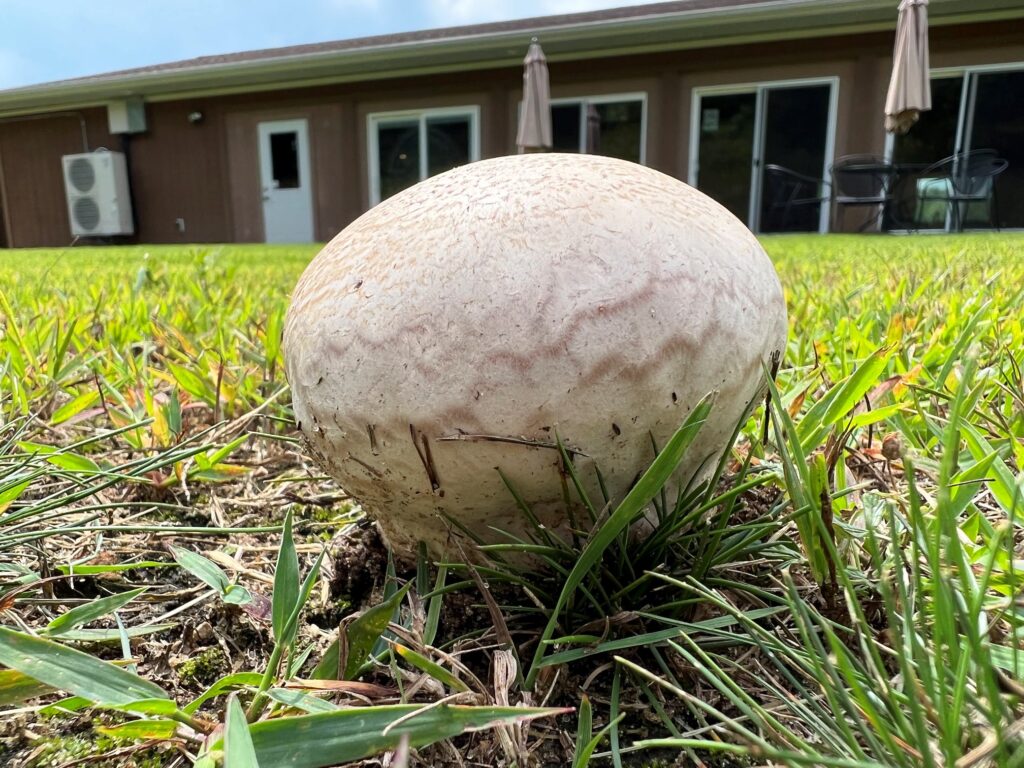Back Home by Chris Hardie
- Download column
- Download the photos that accompany this story
- Chris Hardie’s headshot

Summer is rushing by and to paraphrase the lyrics of my favorite male rock vocalist Bob Seger, autumn’s closing in.
The shorter days and foggy mornings are evidence enough that the sun continues its equatorial descent, but there are other signs in nature. Like the appearance of puffballs.
Puffballs can be as small as marbles to as large as basketballs. They are frequent during the late summer and fall and are showing up in our yard. The surfaces are sometimes smooth or covered with bumps or spikes. They look like balls because they don’t have a stem, like other mushrooms.
Giant puffballs from the genus Calvatia are filled with spores. The ripe mushroom can contain as many as seven trillion spores that erupt with a puff of fungal smoke when it bursts open — either naturally or with a kick.
The dry spores are supposedly effective as a coagulant. The entire Milwaukee Brewers baseball team should bathe in the spores to stop their late-season bleeding.
Puffballs are actually edible — if they are completely white and don’t have any gills inside. They are part of the 30 mushrooms that grow wild in the Wisconsin woods that are edible, according to the Wisconsin Mycological Society.
While many take to the woods in the spring for the popular morel mushrooms, autumn is actually the better season for fungi like honey, oyster, bearded/combs tooth, sulfur shelf, hen of the woods, shaggy mane and chanterelle.
I know many of these fungi grow on our farm, but I am somewhat flummoxed by the fall fungi foraging — even with detailed photos and descriptions found on the internet. There are experienced foragers who can point out the differences.
The Wisconsin Mycology Society offers guided forays throughout the fall. Check them out at https://www.wisconsinmycologicalsociety.org/events.html
Another sign of warm days and cool nights is the morning appearance in the yard of dollar spot fungus. The branching mycelium of dollar spot fungus looks like spider webs or cobwebs on morning grass, but disappears when the dew dries.
Poor soil and poor lawn maintenance is the cause, which starts as small brown spots the size of dollar coins, hence the name. Apparently, I am rich with poor soil because many of our dollar spots are the size of legal papers.
It has been a challenging summer for our yard and garden with several weeks of dryness that was alleviated by some recent rains. Good thing we’re not relying on our vegetable harvest to sustain us through the winter.
The hummingbirds have certainly put on a show for us this summer. Until recently we were filling our three feeders almost daily and we enjoy watching the dive-bombing aerial show.
In a few weeks, the hummingbirds will begin their seasonal departure south.
Males typically leave earlier, so they can stake the best seats for the upcoming football season. The females and the young will fend for themselves before joining them.
Christians sometimes associate hummingbirds with the resurrection, sleeping still overnight like death before resuming its boundless energy at dawn; a messenger from heaven.
Native Americans believe the birds are a symbol of luck, devotion, permanence and the cycle of life.
In a few weeks it will be fall.
The cycle of life turns.
Chris Hardie spent more than 30 years as a reporter, editor



